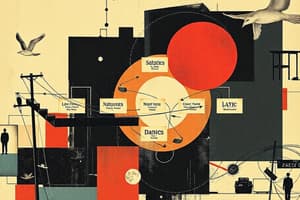Podcast
Questions and Answers
Which of the following is NOT one of the four characteristics of charismatic leaders?
Which of the following is NOT one of the four characteristics of charismatic leaders?
- Are sensitive to follower needs
- Have a vision
- Exhibit behaviors that are out of the ordinary
- Prioritize rewards over expectations (correct)
Charismatic leaders do not need to be willing to take personal risks to achieve their vision.
Charismatic leaders do not need to be willing to take personal risks to achieve their vision.
False (B)
What is the purpose of a vision statement in leadership?
What is the purpose of a vision statement in leadership?
To outline a formal, long-term strategy to attain goals.
Charismatic leaders communicate high performance expectations and express ______ in their followers' abilities.
Charismatic leaders communicate high performance expectations and express ______ in their followers' abilities.
Match the following leadership traits with their descriptions:
Match the following leadership traits with their descriptions:
What is one of the strengths of a simple/flat organizational structure?
What is one of the strengths of a simple/flat organizational structure?
Bureaucratic structures allow for a high degree of employee autonomy.
Bureaucratic structures allow for a high degree of employee autonomy.
What are the two types of structures mentioned that are characteristic of the bureaucratic organizational framework?
What are the two types of structures mentioned that are characteristic of the bureaucratic organizational framework?
In the matrix structure, departmentalization combines functional and _______ departmentalization.
In the matrix structure, departmentalization combines functional and _______ departmentalization.
Match the types of organizational structure with their characteristics:
Match the types of organizational structure with their characteristics:
Which of the following is a weakness of bureaucratic structures?
Which of the following is a weakness of bureaucratic structures?
A matrix organizational structure has a single chain of command.
A matrix organizational structure has a single chain of command.
What is one advantage of having employees report to two bosses?
What is one advantage of having employees report to two bosses?
Non-sanctioned leadership is less important than formal leadership.
Non-sanctioned leadership is less important than formal leadership.
What is the primary aim of an innovation strategy?
What is the primary aim of an innovation strategy?
The principle that suggests employees should have only one boss is called the _____ principle.
The principle that suggests employees should have only one boss is called the _____ principle.
Match the leadership theories to their focus:
Match the leadership theories to their focus:
What is a common disadvantage of having multiple bosses?
What is a common disadvantage of having multiple bosses?
Organizational structures differ only because of technology.
Organizational structures differ only because of technology.
What do managers primarily focus on in an organization?
What do managers primarily focus on in an organization?
Leaders need to challenge the _____ to inspire organizational members.
Leaders need to challenge the _____ to inspire organizational members.
Which of the following options does NOT describe the characteristics of trust?
Which of the following options does NOT describe the characteristics of trust?
Effective group performance is determined entirely by the leader's style.
Effective group performance is determined entirely by the leader's style.
What is the main purpose of recognizing each employee's strengths?
What is the main purpose of recognizing each employee's strengths?
The _____ theory emphasizes the fit between leader style and the situation's control.
The _____ theory emphasizes the fit between leader style and the situation's control.
Match the following leadership theories with their focus:
Match the following leadership theories with their focus:
In Hersey and Blanchard’s Situational Theory, if a follower is unable but willing, what is the recommended leader approach?
In Hersey and Blanchard’s Situational Theory, if a follower is unable but willing, what is the recommended leader approach?
Path-Goal Theory suggests that leaders should ignore the desired outcomes of their subordinates.
Path-Goal Theory suggests that leaders should ignore the desired outcomes of their subordinates.
What three factors does Fiedler identify as crucial to a leadership situation?
What three factors does Fiedler identify as crucial to a leadership situation?
The foundation of _____ is based on honesty, respect, and integrity.
The foundation of _____ is based on honesty, respect, and integrity.
According to effective management practices, what is important to praise among employees?
According to effective management practices, what is important to praise among employees?
Which trait is considered a leadership trait according to trait theories?
Which trait is considered a leadership trait according to trait theories?
Behavioral theories focus on the traits of leaders rather than their actions.
Behavioral theories focus on the traits of leaders rather than their actions.
What is one advantage of understanding leadership traits?
What is one advantage of understanding leadership traits?
A _____-oriented leader emphasizes interpersonal relations.
A _____-oriented leader emphasizes interpersonal relations.
Match the following behavioral dimensions with their descriptions:
Match the following behavioral dimensions with their descriptions:
Which statement best describes the relationship between leadership traits and effectiveness?
Which statement best describes the relationship between leadership traits and effectiveness?
Great leaders may share a definitive list of characteristics.
Great leaders may share a definitive list of characteristics.
What is one key aspect that great leaders do to maximize their teams?
What is one key aspect that great leaders do to maximize their teams?
The Blake and Mouton model considers both concern for _____ and concern for people.
The Blake and Mouton model considers both concern for _____ and concern for people.
According to the behavioral theories, what is a characteristic of a 'Produce or Perish' leadership style?
According to the behavioral theories, what is a characteristic of a 'Produce or Perish' leadership style?
Flashcards
Functional structure
Functional structure
A type of organization structure where tasks are divided into specialized jobs grouped by function (e.g., marketing, finance), with a clear chain of command and centralized decision-making.
Divisional structure
Divisional structure
A type of organization structure where employees are grouped based on the products, services, customers, or geographical location they serve, creating separate divisions for each.
Matrix structure
Matrix structure
An organizational structure that combines functional and product departmentalization, with a dual chain of command. Employees report to both a functional manager and a product manager.
Simple/Flat structure
Simple/Flat structure
Signup and view all the flashcards
Bureaucracy
Bureaucracy
Signup and view all the flashcards
Formalization
Formalization
Signup and view all the flashcards
Centralization/Decentralization
Centralization/Decentralization
Signup and view all the flashcards
Mechanistic Structure
Mechanistic Structure
Signup and view all the flashcards
Organic Structure
Organic Structure
Signup and view all the flashcards
Leadership
Leadership
Signup and view all the flashcards
Trait Theories of Leadership
Trait Theories of Leadership
Signup and view all the flashcards
Behavioral Theories of Leadership
Behavioral Theories of Leadership
Signup and view all the flashcards
Contingency Theories of Leadership
Contingency Theories of Leadership
Signup and view all the flashcards
Innovation Strategy
Innovation Strategy
Signup and view all the flashcards
Cost-Minimization Strategy
Cost-Minimization Strategy
Signup and view all the flashcards
Rewarding Desired Outcomes
Rewarding Desired Outcomes
Signup and view all the flashcards
Vision Statement
Vision Statement
Signup and view all the flashcards
Charismatic Leadership
Charismatic Leadership
Signup and view all the flashcards
Charismatic Leader Qualities
Charismatic Leader Qualities
Signup and view all the flashcards
How Charismatic Leaders Influence
How Charismatic Leaders Influence
Signup and view all the flashcards
Impact of AI on Leadership
Impact of AI on Leadership
Signup and view all the flashcards
Extroversion
Extroversion
Signup and view all the flashcards
Conscientiousness
Conscientiousness
Signup and view all the flashcards
Openness
Openness
Signup and view all the flashcards
Emotional Intelligence
Emotional Intelligence
Signup and view all the flashcards
Initiating Structure
Initiating Structure
Signup and view all the flashcards
Consideration
Consideration
Signup and view all the flashcards
Ohio State vs. Michigan Studies
Ohio State vs. Michigan Studies
Signup and view all the flashcards
Contingency Leadership
Contingency Leadership
Signup and view all the flashcards
Fiedler Contingency Model
Fiedler Contingency Model
Signup and view all the flashcards
Leader-Member Relations
Leader-Member Relations
Signup and view all the flashcards
Task Structure
Task Structure
Signup and view all the flashcards
Position Power
Position Power
Signup and view all the flashcards
Hersey and Blanchard's Situational Theory
Hersey and Blanchard's Situational Theory
Signup and view all the flashcards
Follower Readiness
Follower Readiness
Signup and view all the flashcards
Path-Goal Theory
Path-Goal Theory
Signup and view all the flashcards
Desired Outcomes
Desired Outcomes
Signup and view all the flashcards
Path Obstacles
Path Obstacles
Signup and view all the flashcards
Study Notes
Organizational Structure
- Organizational structure defines how job tasks are formally divided, grouped, and coordinated.
- Key questions in organizational structure include:
- To what degree are tasks subdivided into separate jobs?
- On what basis will jobs be grouped?
- To whom do individuals and groups report?
- How many individuals can a manager effectively direct?
- Where does decision-making authority lie?
- To what degree will there be rules and regulations?
- Do individuals from different areas need to regularly interact?
- Answers to these questions outline various structures, including work specialization, departmentalization, chain of command, span of control, centralization/decentralization, and formalization. Boundary spanning is another significant aspect.
Organizational Structure Types
- Bureaucratic: Hierarchical structure with clear lines of authority, high formalization, and specialization.
- Flat: Decentralized structure with wide spans of control and limited formalization.
- Matrix: Combines functional and product departmentalization, creating a dual chain of command.
Simple/Flat Structure
- Characterized by low departmentalization, wide spans of control, and centralized authority.
- Strengths: Simple, fast, flexible, inexpensive, and clear accountability.
- Weaknesses: Can be slow in decision-making in large organizations, risky as it relies on a single person, and problematic if the leader is not strong. Best suited to small organizations.
Bureaucracy
- Structure with standardized activities, economies of scale, and lower employee costs.
- Strengths: Efficient performance of standardized activities, economical economies of scale, and minimum duplication of personnel and equipment. Lower quality employees are acceptable, reducing costs.
- Weaknesses: Subunit conflicts, obsessive concern with rules, frozen processes, and hampered innovation.
Bureaucracy (Functional and Divisional):
- Functional: Groups employees by their similar specialties, roles, or tasks.
- Divisional: Groups employees into units by product, service, customer, or geographical market area.
Matrix Structure
- Combines functional and product departmentalization with a dual chain of command.
- Advantages: Facilitates coordination when there are many activities; provides more communication; allocates specialists efficiently.
- Disadvantages: Power struggles, confusion, and stress.
Mechanistic vs. Organic Structure
- Mechanistic: High specialization, rigid departmentalization, clear chain of command, narrow spans of control, centralization, and high formalization.
- Organic: Cross-functional teams, cross-hierarchical teams, free flow of information, wide spans of control, decentralization, and low formalization.
Reasons for Structural Differences
- Organizational strategy (e.g., innovation, cost-minimization).
- Size.
- Technology.
- Environment (suppliers, customers, competitors).
- Institutions
Leadership
- Leadership is the ability to influence a group toward the achievement of a vision or set of goals. Formal and non-sanctioned leadership are two types.
- Effective leadership requires challenging the status quo, envisioning the future, motivating others, and establishing efficient organizational structures. The role of day-to-day operations is important.
Leadership Theories
- Trait theories: Focus on distinguishing characteristics of leaders.
- Behavioral theories: Examine the behaviors of leaders.
- Contingency theories: Analyze how effective leadership depends on the situation.
Approaches to Leadership
- Contingency: (Situational) Leadership, focusing on context and matching leader style to situation:
- Fiedler Contingency Model
- Hersey and Blanchard's Situational Theory
- Path-Goal Theory
Further Leadership Topics
-
Charismatic: Leaders who inspire others and have personal, vision-driven qualities.
-
Transformational: Leaders who inspire followers to transcend self-interests and can effect profound change.
-
Authentic: Leaders who know themselves, their values, and beliefs, acting transparently on those principles.
-
Servant: Leaders who focus on serving followers' needs and assisting in their growth.
-
Mentoring: Guiding less experienced employees.
-
Great Leaders and Managers: Focus on strengths, surrounding oneself with good people, understanding followers, and demonstrating trust, compassion, stability, and hope.
-
Followership: Emphasizes developing the qualities of a great follower to facilitate leadership.
Studying That Suits You
Use AI to generate personalized quizzes and flashcards to suit your learning preferences.
Related Documents
Description
Explore the essential aspects of organizational structure, including task division, job grouping, and reporting relationships. This quiz delves into different structures such as bureaucratic and flat, along with concepts like span of control and centralization. Understand how these elements influence decision-making and interactions within an organization.




